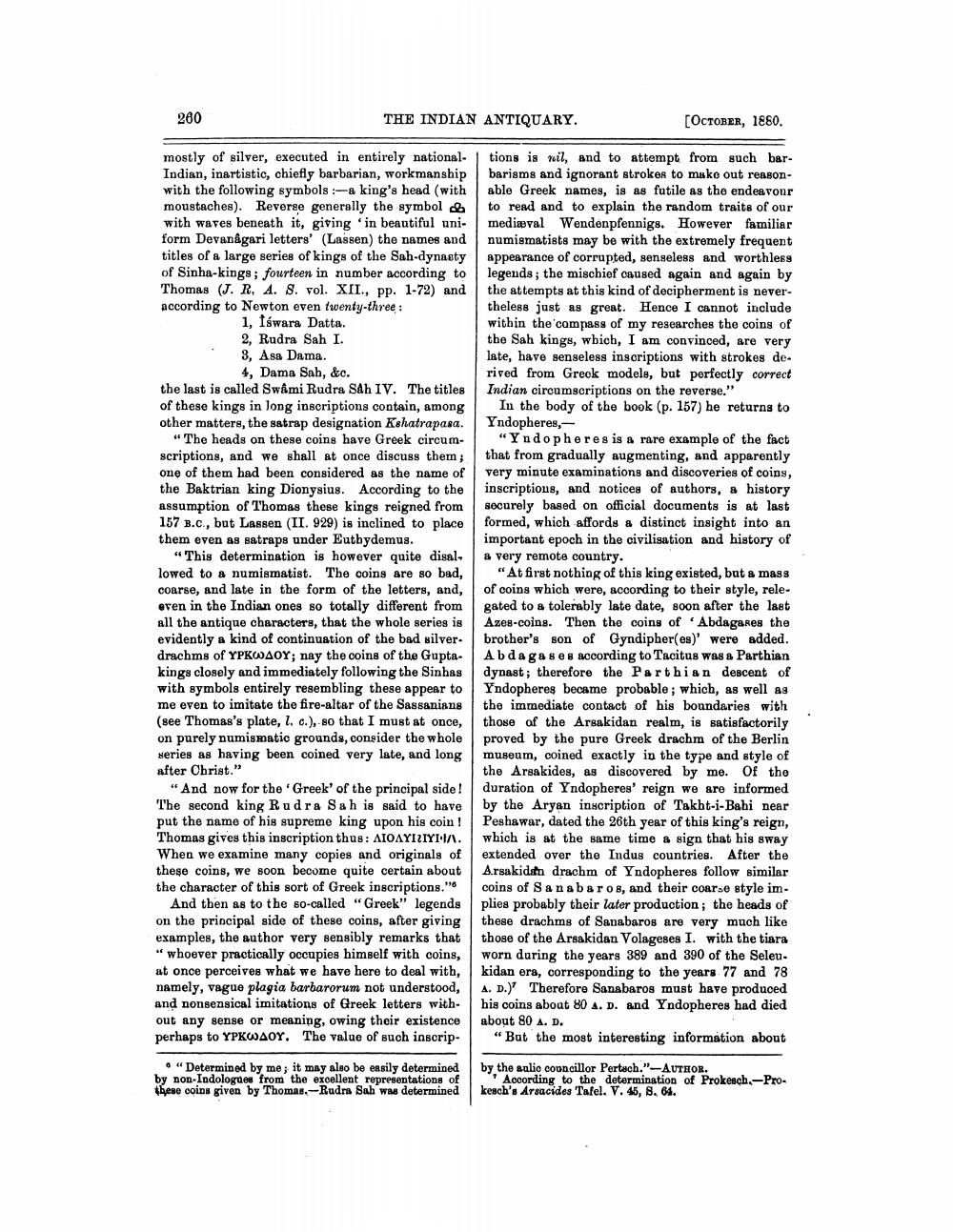________________
260
THE INDIAN ANTIQUARY.
[OCTOBER, 1880.
mostly of silver, executed in entirely national. Indian, inartistic, chiefly barbarian, workmanship with the following symbols :-a king's head (with moustaches). Reverse generally the symbol o with waves beneath it, giving in beautiful uni- form Devanagari letters' (Lassen) the names and titles of a large series of kings of the Sah-dynasty of Sinha-kings; fourteen in number according to Thomas (J. R. A. 8. vol. XII., pp. 1-72) and according to Newton even twenty-three :
1, fswara Datta. 2, Rudra Sah I. 3, Asa Dama.
4, Dama Sah, &c. the last is called Swami Rudra Sah IV. The titles of these kings in long inscriptions contain, among other matters, the satrap designation Kshatrapasa.
"The heads on these coins have Greek circumscriptions, and we shall at once discuss them; one of them had been considered as the name of the Baktrian king Dionysius. According to the assumption of Thomas these kings reigned from 157 B.C., but Lassen (II. 929) is inclined to place them even as satraps under Eutbydemus.
"This determination is however quite disal. lowed to a numismatist. The coins are so bad, coarse, and late in the form of the letters, and, even in the Indian ones so totally different from all the antique characters, that the whole series is evidently a kind of continuation of the bad silver. drachms of YPKWAOY; nay the coins of the Guptakings closely and immediately following the Sinhas with symbols entirely resembling these appear to me even to imitate the fire-altar of the Sassanians (see Thomas's plate, l. c.), so that I must at once, on purely numismatic grounds, consider the whole Neries as having been coined very late, and long after Christ."
"And now for the Greek' of the principal side! The second king Rudra Sah is said to have put the name of his supreme king upon his coin! Thomas gives this inscription thus: AIOAYIZIYI A. When we examine many copies and originals of these coins, we soon become quite certain about the character of this sort of Greek inscriptions."
And then as to the so-called "Greek" legends on the principal side of these coins, after giving examples, the author very sensibly remarks that "whoever practically occupies himself with coins, at once perceives what we have here to deal with, namely, vague plagia barbarorum not understood, and nonsensical imitations of Greek letters with out any sense or meaning, owing their existence perhaps to YPKWAY. The value of such inscrip
tions is wil, and to attempt from such barbarisms and ignorant strokes to make out reasonable Greek names, is as futile as the endeavour to read and to explain the random traits of our mediæval Wendenpfennigs. However familiar numismatists may be with the extremely frequent appearance of corrupted, senseless and worthless legends; the mischief caused again and again by the attempts at this kind of decipherment is nevertheless just as great. Hence I cannot include within the compass of my researches the coins of the Sah kinge, which, I am convinced, are very late, have senseless inscriptions with strokes de. rived from Greek models, but perfectly correct Indian circumscriptions on the reverse."
In the body of the book (p. 157) he returns to Yndopheres,
"Y ndopheres is a rare example of the fact that from gradually augmenting, and apparently very minute examinations and discoveries of coins, inscriptions, and notices of authors, a history securely based on official documents is at last formed, which affords & distinct insight into an important epoch in the civilisation and history of a very remote country.
"At first nothing of this king existed, but a mass of coins which were, according to their style, rele. gated to a tolerably late date, soon after the last Azes-coins. Then the coins of Abdagares the brother's son of Gyndipher(es)' were added. Abdagases according to Tacitus was a Parthian dynast; therefore the Parthian descent of Yndopheres became probable; which, as well as the immediate contact of his boundaries with those of the Arsakidan realm, is satisfactorily proved by the pure Greek drachm of the Berlin museum, coined exactly in the type and style of the Arsakides, as discovered by me. Of the duration of Yndopheres' reign we are informed by the Aryan inscription of Takht-i-Babi near Peshawar, dated the 26th year of this king's reign, which is at the same time a sign that his sway extended over the Indus countries. After the Arsakiden drachm of Yndopheres follow similar coins of Sanabaros, and their coarse style implies probably their later production; the heads of these drachms of Sanabaros are very much like those of the Arsakidan Volageses I. with the tiara worn during the years 389 and 390 of the Seleu. kidan era, corresponding to the years 77 and 78 A. D.) Therefore Sanabaros must have produced his coins about 80 A. D. and Yndopheres had died about 80 A. D.
"But the most interesting information about
• "Determined by me; it may also be easily determined by non-Indologues from the excellent representations of these coins given by Thomas.-Rudra Sah was determined
by the aulic councillor Pertach."-AUTHOR.
According to the determination of Prokesch.-Prokesch's Arsacides Tafel. V. 45, 8. 64.




